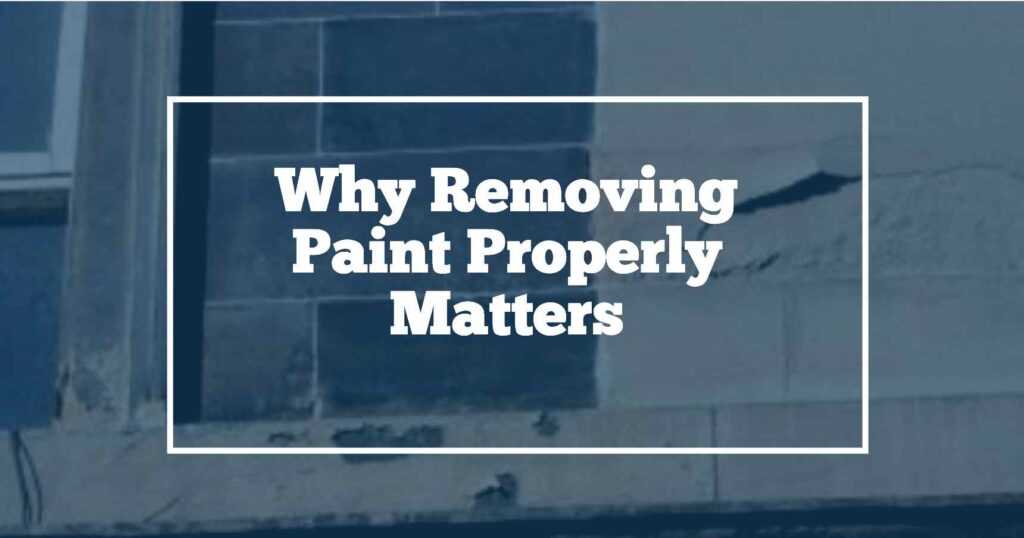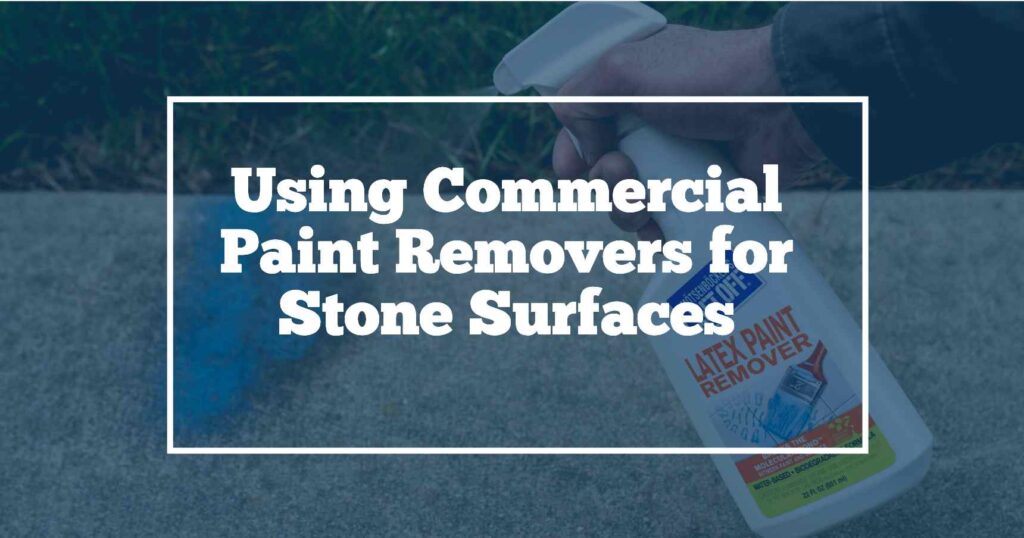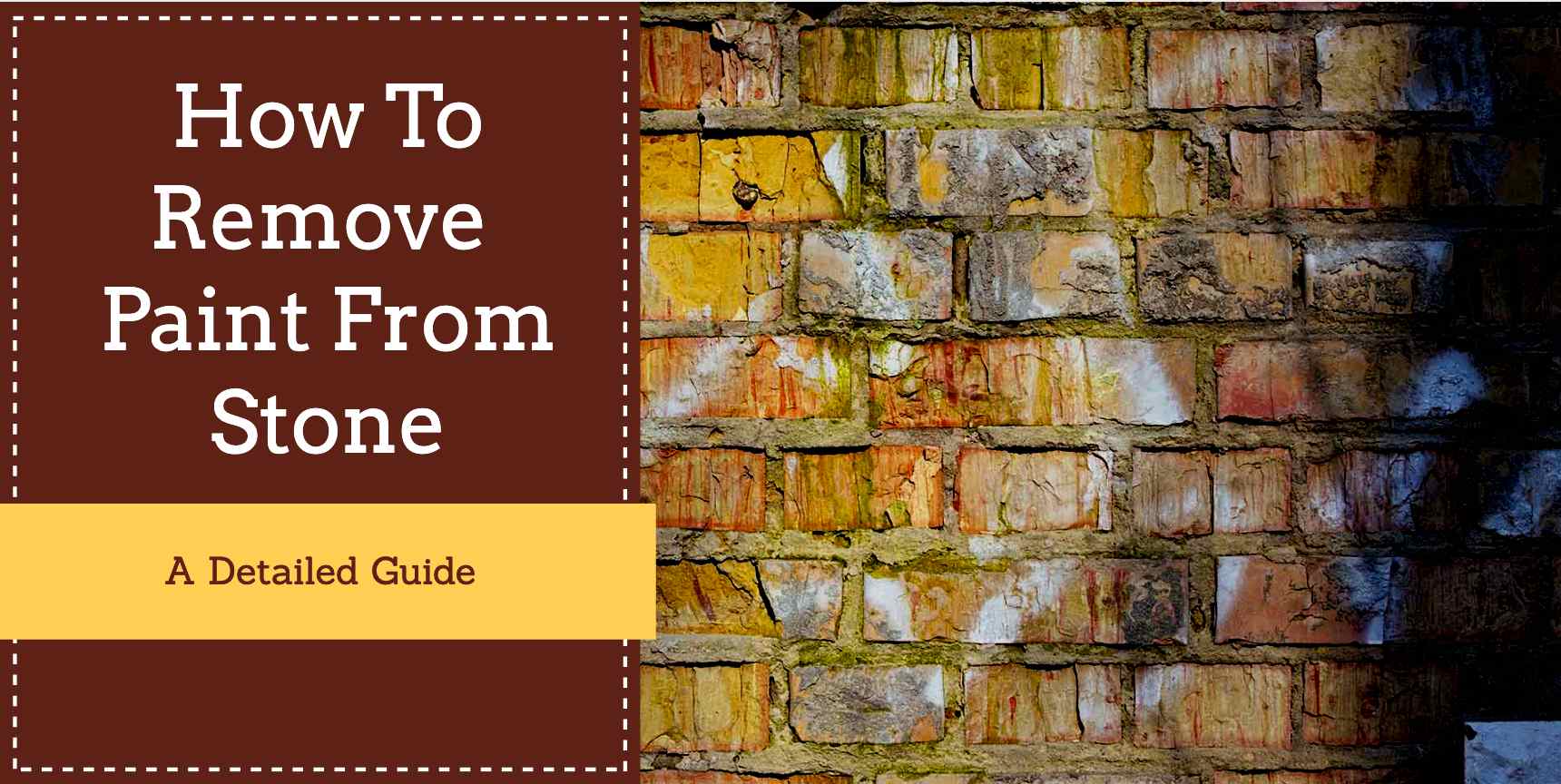If you’ve accidentally got paint on your stone stuff while painting, No problem! Here in this article, we’ll let you know how you can remove paint from stone with ease. Learning how to remove paint from stone is like finding a cool secret, you’ll see the beauty of your stone stuff shine after removing all the unwanted paint from it.
Whether it’s a wall outside, a path made of stones, or a neat sculpture, this guide will act like a friend helping you learn different ways to get rid of paint marks. We’ll talk about easy tricks for delicate stones, try out some strong solutions, and even talk about stopping paint messes next time. So, get ready and grab your tools!
Why Removing Paint Properly Matters

Removing paint might not seem like a big deal, but doing it the right way is actually pretty important. As, when paint sticks around on surfaces like stone, it can mess things up. It might stain the surface, change its color, or even wreck it. Stones are tricky because they can soak up paint, which makes it harder to get rid of. Nobody wants their cool stone stuff to look all weird and painted over.
So, taking the time to remove paint the right way from the vinyl floor or stone is a smart move. It keeps your stuff looking nice, prevents any damage, and makes sure everything stays valuable. Just keep reading, and we’ll show you how to do it like a pro!
Identifying Your Stone and Understanding the Effects of Paint Removal From Stone
Before you start removing paint from your stone surfaces, it’s super important to know what type of stone you’re working with and how taking off the paint might affect it. Different stones do different things, some have little holes that can soak up paint, while others are more solid. When you get rid of paint from stone, it could make marks, change the color, or even mess up the surface if you’re not careful. But don’t worry, We’ll guide you through figuring out your stone type and help you see how to paint removal could affect it. This way, you’ll know exactly what to do and can keep your stone looking awesome after the paint is gone.
Before you get ready to deal with that paint, let’s make sure you’re all set. Gather up all the stuff you’ll need, mild dish soap, warm water, soft cloths or sponges, a plastic scraper, rubbing alcohol, white vinegar, baking soda, a paint remover that’s safe for stone, gloves, and goggles to keep your hands and eyes safe.
Stone Paint Removal Using Mild Dish Soap
Removing paint from stone surfaces requires a gentle touch, and we’ve got the perfect step-by-step guide to help you through the process. Here’s how to do it:
Step 1: Get Ready With Your Supplies Before you start, make sure you have everything you need mild dish soap, warm water, soft cloths or sponges, a plastic scraper, rubbing alcohol, white vinegar, baking soda, a stone-safe paint remover, gloves, and goggles for protection.
Step 2: Mix Soap and Water In a bowl, mix some warm water with mild dish soap. This will be your cleaning solution.
Step 3: Dip and Rub Dip a soft cloth or sponge into the soapy water and gently rub the painted area. Use circular motions and be careful not to scratch the stone.
Step 4: Dab with Rubbing Alcohol For tougher paint, wet a cloth or cotton ball with rubbing alcohol. Gently dab the painted spot to break down the paint.
Step 5: Rinse and Repeat After using soap or rubbing alcohol, rinse the stone with clean water to remove any residue. If needed, you can repeat these steps until the paint is gone.
Step 6: Review the Results Take a look at your stone, the paint should be fading away. If there’s still some paint left, don’t worry. We have more methods to explore.
Stone Paint Removal Using Sanding
If the above method doesn’t work, it’s time to bring in some mechanical muscle to remove that paint from your stone surfaces. Here’s a step-by-step guide to help you out:
Step 1: Analyse the Surface Before you start, take a good look at the stone. Make sure it’s sturdy and won’t get damaged by mechanical methods like sanding or power washing.
Step 2: Sanding Preparation For sanding, you’ll need sandpaper or a sanding block. Choose a grit that’s not too rough, something like 220 grit works well.
Step 3: Gently Sand Using gentle pressure, start sanding the painted area in a circular motion. Keep the sandpaper wet to prevent dust from spreading.
Step 4: Check Your Progress Regularly stop and check how the paint is coming off. Once the paint is gone, wipe the area clean.
Step 5: Power Washing Setup If you’re going for power washing, make sure you have a pressure washer with a low-pressure nozzle attachment.
Step 6: Power Wash Carefully Hold the pressure washer nozzle at a safe distance from the stone and use a low-pressure setting. Move-in sweeping motions to remove the paint.
Step 7: Rinse and Inspect After power washing, rinse the stone with clean water. Check if the paint is completely gone, and let the stone dry.
Step 8: Evaluate the Outcome Give your stone a close look to see if the paint is history. If there’s still a bit left, don’t worry we’ve got more techniques to explore.
Just remember, mechanical methods need a delicate touch too. Always be mindful of the stone’s condition and take your time.
Stone Paint Removal Using Household Remedies
These simple household remedies can work wonders in tackling that unwanted paint. Let’s check some of the effective options:
Option 1: Vinegar and Baking Soda Create a paste by mixing equal parts white vinegar and baking soda. Spread the paste over the paint and wait for about 20 minutes. Then, use a soft cloth or sponge to gently scrub the area. The chemical reaction between vinegar and baking soda helps loosen the paint.
Option 2: The Magic of Lemon Juice Lemon juice isn’t just for your favorite drinks, it’s also a natural paint remover! Squeeze some lemon juice onto the painted spot and let it sit for a while. The acidity of the lemon will work its magic and help lift the paint.
Option 3: Warm Soapy Water Sometimes, the simplest solution is the best one. Mix warm water with a bit of mild dish soap, dip a cloth or sponge in the soapy water, and gently rub the paint. This method is great for lighter paint marks.
Option 4: Rubbing Alcohol Wet a cloth or cotton ball with rubbing alcohol and gently work on the painted area. The alcohol breaks down the paint, making it easier to remove.
Remember, these household remedies are effective and gentle, but it’s always a good idea to test them on a small, hidden area of the stone first. Once you’re sure they won’t cause any harm, go ahead and give these methods a try to say goodbye to that paint!
Stone Paint Removal Using Commercial Paint Removers

When you’re facing a tough paint challenge on your stone surfaces, it’s time to use commercial paint removers now. These specialized products are designed to tackle stubborn paint marks and help restore the original beauty of your stone. This is one of the best paint removal methods for asphalt also, Let’s explore how to use it effectively:
Step 1: Select a Stone-Safe Remover Head to your local hardware or home improvement store and look for a paint remover specifically labeled as safe for stone surfaces. Read the label carefully to ensure it’s suitable for your stone type.
Step 2: Ready With Your Gear Besides the paint remover, you’ll need gloves, goggles, a paintbrush, a plastic scraper, and a soft cloth or sponge.
Step 3: Prepare the Work Area Work in a well-ventilated area and protect any surrounding surfaces that you don’t want the remover to touch. Stone-safe removers are strong, so it’s better to be safe than sorry.
Step 4: Apply the Remover Dip the paintbrush into the remover and apply a generous coat over the painted area. Make sure it’s completely covered.
Step 5: Wait and Watch Check the manufacturer’s instructions for the recommended wait time. During this period, the remover will start breaking down the paint.
Step 6: Gently Remove the Paint After the waiting time, use a plastic scraper to gently scrape off the softened paint. Be careful not to scratch the stone surface.
Step 7: Clean Up Wipe the area with a soft cloth or sponge dampened with water to remove any leftover residue from the remover.
Step 8: Check the Results Stand back and take a look , your stone should be looking much better without that pesky paint!
Remember, commercial paint removers can be potent, so always follow the manufacturer’s instructions and wear protective gear.
Taking Precautions and Avoiding Further Damage
When it comes to removing paint from stone, it’s not just about getting rid of the paint, it’s also about making sure you don’t accidentally cause any harm to the stone itself. Here are some precautions to keep in mind to avoid further damage:
Protective Measures Before You Start: Before you even begin the paint removal process, take a moment to protect your stone and surrounding areas. Cover nearby surfaces with plastic sheets or drop cloths to prevent any accidental splatters or spills from reaching other parts of your space.
Painter’s Tape: Your Friend in Prevention: Painter’s tape is your secret weapon for keeping paint where it belongs. Use it to create a protective barrier around the edges of the stone, so you don’t accidentally get paint on areas you want to keep clean.
Do it Gently: When you’re scrubbing or scraping off paint, remember to be gentle. You don’t want to scratch or damage the stone’s surface. Use soft cloths, gentle brushes, and plastic scrapers to avoid any unintended harm.
Choosing the Right Remover: If you’re using a paint remover, make sure it’s safe for your specific type of stone. Some removers might be too strong for delicate stones, so always check the label and test a small, hidden area before applying it to the entire surface.
Rinse, Rinse, Rinse: After using any kind of remover or cleaning solution, make sure to rinse the stone thoroughly with clean water. This helps get rid of any leftover chemicals that could potentially harm the stone in the long run.
Avoid Harsh Tools: Stay away from abrasive tools like steel wool or harsh brushes. They might remove the paint, but they can also leave scratches or marks on the stone.
Stay Patient: Removing paint takes time and patience. Rushing through the process could lead to accidents or damage. So, take your time and enjoy the satisfaction of revealing a beautifully clean stone surface.
By taking these precautions, you’ll not only successfully remove the paint but also ensure that your stone remains in its pristine condition.
How To Remove Paint From Stone Fireplace
To remove paint from a stone fireplace, start by testing a small area with a stone-safe paint stripper to check if it isn’t harming the stone. Once confirmed, apply the paint stripper evenly on the painted sections and cover them with plastic wrap for about 15-30 minutes to keep them moist and effective. Now, gently scrape away the softened paint with a plastic scraper, being careful not to damage the stone. To finish, clean the area using a soft brush and a mixture of mild dish soap and water. Rinse thoroughly with clean water and dry with a cloth. If needed, repeat the process until the paint is completely removed. This method should help restore your stone fireplace’s original appearance without causing any harm.
How To Remove Mansory Paint From Stone
Removing masonry paint from stone requires a careful approach. start by conducting a small area test with a masonry-safe paint stripper to ensure it won’t harm the stone. Once you’ve confirmed its suitability, apply the paint stripper evenly across the painted areas, keeping the manufacturer’s guidelines in mind.
Cover the treated areas with plastic wrap, allowing the stripper to work for the recommended time, typically 15-30 minutes. Afterward, carefully scrape away the softened paint using a plastic scraper or putty knife, taking care not to damage the stone.
To finish, clean the area with a mixture of mild dish soap and water, using a soft-bristle brush or nylon scrubber. Rinse thoroughly with clean water and dry with a cloth or paper towel. If necessary, repeat the process until the paint is entirely removed. This approach will effectively eliminate masonry paint from your stone surface without compromising its quality.
Frequently Asked Questions (FAQs)
Q: How do I choose the right method for paint removal from stone?
A: The best method depends on your stone type and the type of paint you need to remove. Start with gentle methods and move to more intense ones if needed.
Q: Can I use regular paint removers on all types of stones?
A: Not all paint removers are safe for all stones. Some can damage delicate stones. Always check labels and do a small test before using.
Q: Is sanding safe for all types of stones?
A: Sanding can be effective, but it’s not suitable for all stones. It’s best for harder stones and should be done carefully to avoid damage.
Q: How can I prevent paint stains on my stone surfaces?
A: Cover nearby areas with plastic sheets or painter’s tape before painting. This prevents accidental spills and splatters.
Q: What if I accidentally scratch my stone while removing paint?
A: If you notice scratches, you can try polishing the stone or using fine-grit sandpaper to buff out the marks.
Q: Is it possible to remove paint from porous stones?
A: Yes, but it can be trickier. Porous stones absorb the paint, so you’ll need to be patient and choose gentle methods to avoid damaging the stone.
Q: Can I remove paint without any chemicals?
A: Yes, you can use gentle methods like warm soapy water or vinegar and baking soda to remove paint without harsh chemicals.
Q: Should I seek professional help for paint removal from stones?
A: If you’re unsure or dealing with valuable stones, seeking professional help is a good idea to ensure the stone’s integrity.
Q: Can I prevent paint from getting on stone surfaces in the first place?
A: Absolutely! Use painter’s tape to cover the edges of the stone before painting. It acts as a barrier to keep paint off the stone.
Q: How long does it take to remove paint from stone?
A: The time can vary depending on the method, the type of stone, and the amount of paint. Be patient and take your time for the best results.
Conclusion:
And that’s how you can get rid of paint from stone surfaces. From easy-peasy household tricks to commercial magic, you’ve got the lowdown on how to make your stone look like new again.
Removing paint isn’t just about erasing marks. It’s about letting your stone’s natural charm shine through. It’s like giving your stone a makeover that reveals its true self.
So, whether you’re rescuing a cool outdoor wall, a path that’s seen better days, or a special stone creation, you’ve got the know-how now.

